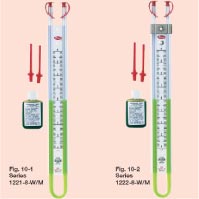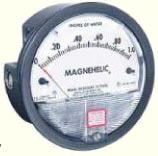|
Alternatives to mercury-containing measuring devices 3 Manometers
3.1 Application of mercury-containing manometersManometers measure the difference in gas pressure. Mercury manometers are most often mercury-containing U-shaped glass or plastic tubes that have both or one end open. The difference in the levels of mercury in each side of the tube indicates the pressure of the gas being measured. Other designs are also available, e.g. slack tube manometers and well-type manometers. In Denmark, sale of mercury manometers (except for sphygmomanometers discussed in chapter 6) are only allowed for calibration of other manometers. U-tube manometers are used for measuring at relatively low pressures. The tubes may be filled with water, alcohol or mercury. U-tube manometers with water are today in Denmark used mainly within the heating and ventilation sector (HVAC sector), e.g. for difference pressure measurements when adjusting oil burners in single family houses (see illustration below). The mercury-filled U- tubes were used for similar purposes in the mid-1990s when measuring at higher pressure (but still at relatively low pressures compared to the range of pressures found in the industry) (Ågård 2006). Besides, mercury manometers were used in the industry and in laboratories (Rasmussen 1992). Laboratories calibrating manometers may still use mercury manometers as reference instruments, but the mercury-containing reference instruments are these years replaced by electronic instruments. For example, the last mercury reference instrument used by the reference laboratory of the Danish Technological Institute is replaced in June 2006 by electronic equipment (Thrane 2006).
Advantages and drawbacks of the mercury-containing equipment The main drawback is that the mercury-containing manometer contain a hazardous substance in a quite fragile glass tube. Over pressuring a mercury manometer can result in the mercury being blown out of the tube contaminating the surroundings. By breakage the mercury may as well be released. Compared to electronic manometers, the mercury manometers are more difficult to read and more difficult to handle. Previous mercury consumption in Denmark The number of manometers sold in 1992/93 (50 pieces) illustrates how marginal the use of mercury for manometers was. The total number of manometers sold in Denmark for industrial use is in the order of magnitude of 1000 times higher. Applications for which mercury may be reintroduced 3.2 Alternatives for main application areasMercury-containing manometers have been replaced for all applications in Denmark A number of different pressure-measuring instruments are marketed, among these:
As mentioned above, mercury manometers accounted for only about one per thousand of the manometers marketed in Denmark in the mid 1990's, and only manometers used for similar applications as the mercury manometers are mentioned below. Bourdon tube manometers Bourdon tube manometers (see example) are today sold for applications, where U-tube manometers with mercury were previously used (Ågård 2006). The market price is about DKK 200 (27 Euro) which is probably lower than it would be for a mercury manometer (Ågård 2006). Plesner (2006) estimates that the price of alternatives to mercury manometers is probably about 1/3 of the price of the mercury manometer.
Electronic (or digital) manometers The electronic manometers are widely used in the industry, as they can be used for automatic and remote control. The price of electronic manometers is estimated to be about 3-4 times the price of a mercury manometer for similar pressure range (Plesner 2006), but the electronic manometers have the advantage of automatic measurements and can for this reason not be directly compared to the mercury manometers. According to Gallican et al. (2003), a digital manometer can also be more precise than the mercury manometer if properly calibrated. Small hand-held manometers, that may serve a similar purpose as the mercury manometers, e.g. for applications within the heating and sanitation sector, are sold by many suppliers (see illustration below). The price of the hand-held manometer is approximately DKK 4000 (530 Euro), corresponding to about 4 times the expected price of a mercury U-tube manometer (Helbo 2006).
3.3 SummaryPrevious to the Danish ban, mercury manometers accounted for only a few percentages of the manometer market. The mercury manometers were used for measuring relatively low pressures, e.g. in the heating and ventilation sector. According to the contacted suppliers alternatives are available at similar or lower price than that of the mercury manometers, and it is highly unlikely that mercury manometers would be reintroduced for any application in Denmark. Table 3.1 Marketed alternatives for mercury-containing thermometers in Denmark
|
||||||||||||||||||||||||


